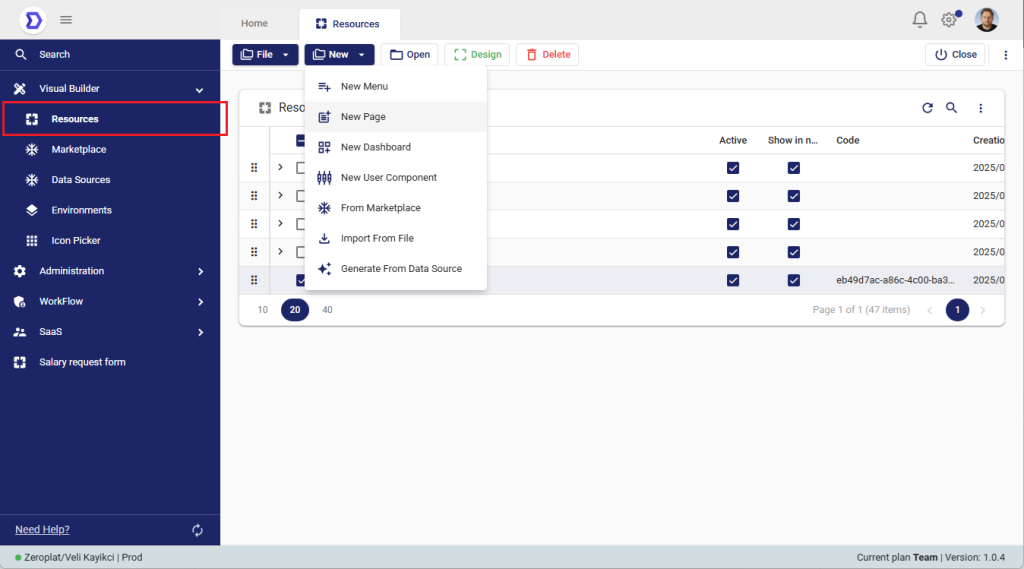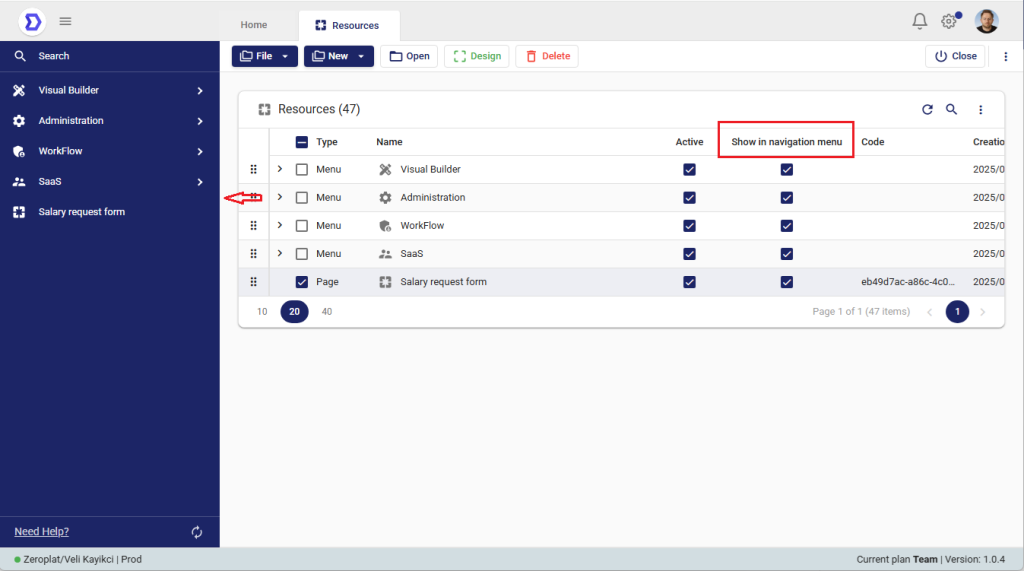The Resources page in Zeroplat is the central hub for managing all key application assets. From here, you can create, organize, and maintain menus, pages, dashboards, and components that make up your applications. In short, Resources is the place where you manage everything that becomes visible and functional in your app.

Key Functions of the Resources Page
1. Navigation and Layout
- Located in the left-hand main menu under Visual Builder → Resources.
- The main panel displays a list of all existing resources (menus, pages, dashboards, etc.).
- Each entry includes details such as:
- Active – Whether the resource is currently enabled.
- Show in Navigation – Indicates if the resource is visible in the app’s navigation menu.
- Code – The unique identifier of the resource.
- Creation Date – When the resource was created.
2. Creating New Resources
By clicking New, you can add new resources to your application. Available options include:
- New Menu – Add a new menu item to the application.
- New Page – Create a new page to display content, forms, or workflows.
- New Dashboard – Build a dashboard with metrics, widgets, and visualizations.
- New User Component – Define reusable UI components for your application.
- From Marketplace – Import prebuilt resources from the Zeroplat Marketplace.
- Import From File – Upload resources directly from a file.
- Generate From Data Source – Automatically generate pages or components based on an existing data source.
3. Managing Existing Resources
- Open – View or edit the selected resource.
- Design – Launch the design view to visually customize the resource.
- Delete – Remove a resource that is no longer needed.
Managing Application Menus from Resources
The Resources page is not only for creating and managing pages, dashboards, and components — it is also where you control the application’s navigation menus.
As shown in the screenshot:
- Each Menu item (e.g., Visual Builder, Administration, WorkFlow, SaaS) is listed in the Resources table.
- The “Show in navigation menu” column determines whether the resource is visible in the application’s left navigation panel.
- Pages (like Salary request form) can also be toggled here to appear or remain hidden from navigation.

Relationship Between the Resource Tree and the Left Navigation Menu
In Zeroplat, the left-side navigation menu and the Resources tree represent the same set of items.
- On the Resources page (right side tree) you can see all defined menus and pages (e.g., Visual Builder, Administration, WorkFlow, SaaS, Salary request form).
- On the left application navigation (sidebar) you see the exact same items — but only if the option “Show in navigation menu” is enabled for that resource.
Explanation
- If Show in navigation menu is checked ✅, the resource (menu/page) will appear in the sidebar navigation for users with the required permission.
- If it is unchecked, the resource will not appear in the sidebar, even though it still exists in the system and can be managed from the Resources page.
This ensures:
- Consistency – The Resources tree is the master list of all menus/pages.
- Control – You decide which of them are visible in the actual navigation.
- Security – Even if “Show in navigation menu” is selected, a user without the proper permission will still not see or open that page.
Why Resources Are Important
- Centralized Control: All essential elements of the application are managed in one place.
- Flexibility: Developers and admins can quickly add or update menus, pages, dashboards, or components.
- Scalability: With marketplace imports and data-source-driven generation, resources can be expanded rapidly.
- Visibility Management: Decide what is active and what should appear in the navigation with just a toggle.
📌 Summary:
The Resources page is the backbone of application structure in Zeroplat. It allows users to create, import, and manage all components — menus, pages, dashboards, and more — ensuring that applications are built and maintained in a consistent and scalable way.